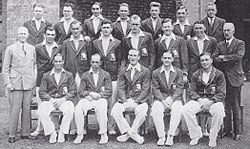Douglas Jardine
Douglas Robert Jardine (Bombay, Indian Empire 23 October 1900 – Montreux, Switzerland 18 June 1958) was an English cricketer and captain of the England cricket team from 1931 to 1933–34.[1] A right-handed batsman, he played 22 Test matches for England, captaining the side in 15 matches, winning nine, losing one and drawing five.
 | ||||||||||||||||||||||||||||||||||||||||
| Personal information | ||||||||||||||||||||||||||||||||||||||||
|---|---|---|---|---|---|---|---|---|---|---|---|---|---|---|---|---|---|---|---|---|---|---|---|---|---|---|---|---|---|---|---|---|---|---|---|---|---|---|---|---|
| Full name | Douglas Robert Jardine | |||||||||||||||||||||||||||||||||||||||
| Born | 23 October 1900 Malabar Hill, Bombay, Bombay Presidency, British India | |||||||||||||||||||||||||||||||||||||||
| Died | 18 June 1958 (aged 57) Montreux, Switzerland | |||||||||||||||||||||||||||||||||||||||
| Batting | Right-handed | |||||||||||||||||||||||||||||||||||||||
| Bowling | Right arm leg break | |||||||||||||||||||||||||||||||||||||||
| Role | Top-order Batsman | |||||||||||||||||||||||||||||||||||||||
| International information | ||||||||||||||||||||||||||||||||||||||||
| National side | ||||||||||||||||||||||||||||||||||||||||
| Test debut (cap 235) | 23 June 1928 v West Indies | |||||||||||||||||||||||||||||||||||||||
| Last Test | 10 February 1934 v India | |||||||||||||||||||||||||||||||||||||||
| Domestic team information | ||||||||||||||||||||||||||||||||||||||||
| Years | Team | |||||||||||||||||||||||||||||||||||||||
| 1920–1923 | Oxford University | |||||||||||||||||||||||||||||||||||||||
| 1921–1933 | Surrey | |||||||||||||||||||||||||||||||||||||||
| 1925–1933/34 | MCC | |||||||||||||||||||||||||||||||||||||||
| Career statistics | ||||||||||||||||||||||||||||||||||||||||
| ||||||||||||||||||||||||||||||||||||||||
Source: Cricinfo, 17 May 2008 | ||||||||||||||||||||||||||||||||||||||||
The 'bodyline' tour
Jardine is best known for captaining the English team during the 1932–33 Ashes tour of Australia. There, his team used 'bodyline' tactics against Donald Bradman and other opposing Australian batsmen. A bodyline delivery was one where the cricket ball was pitched short so as to rise towards the body of the opposing batsman on the line of the leg stump. The plan was to get legside deflections that could be caught by one of several fielders on the leg side. This tactic was considered by many to be intimidatory and physically threatening. Jardine is widely regarded by commentators and writers as the person responsible for that strategy.[2]
The spearhead of the England attack was the coal miner's son Harold Larwood, the fastest bowler of the day.[3] Larwood's partner was Bill Voce, also a top-class fast bowler. Ranged against them was the great Don Bradman, then averaging over 100 in Test matches.
A controversial figure among cricketers, Jardine was well known for his dislike of Australian players and crowds. In return, he was unpopular in Australia, for his manner and the bodyline strategy. Many of his players thought him an excellent captain, though not everyone thought him as good at managing people.
Career in WWII
Jardine joined the British Army in August 1939. Once World War II began, he was commissioned into the Royal Berkshire Regiment and went with the British Expeditionary Force to France. He served at Dunkirk, where he was fortunate to escape but suffered some injuries.[4] After serving as staff captain at St. Albans, he was posted to India for the remainder of the war. He served in Quetta, and then Simla, as a major. He became fluent in the Hindustani language. He gave lectures and played some cricket while in India. He left the army in 1945.[4]
Douglas Jardine Media
A team photograph of England's 1932–33 side: Jardine is seated at the centre of the front row; Pelham Warner is standing at the extreme left.
Jardine addressing an audience at the Hotel Australia on 2BL shortly after his team's arrival in Sydney in November 1932
Australian captain Bill Woodfull facing bodyline bowling from Harold Larwood in the fourth Test at Brisbane 1932–33. Jardine is the third fielder anti-clockwise in the ring, the furthest fielder on the left.
Jardine's Test career batting graph. The red bars indicate the runs that he scored in an innings, and the blue line indicates the batting average in his last 10 innings. The blue dots indicate innings in which Jardine finished not out.
References
- ↑ When describing cricket seasons, the convention used is that a single year represents an English cricket season, while two years (e.g. 1933–34) represent a southern hemisphere cricket season because it takes place over two calendar years (e.g. September to February).
- ↑ Frith, David 2002. Bodyline autopsy: the full story of the most sensational Test cricket series: Australia v England 1932–33. London: Aurum Press. ISBN 1-85410-896-4
- ↑ Hamilton, Duncan 2009. Harold Larwood. London: Quercus. ISBN 978-1-84916-207-4
- ↑ 4.0 4.1 Douglas, Christopher (2002). Douglas Jardine: Spartan cricketer. London: Methuen, p201/3. ISBN 0-413-77216-0






